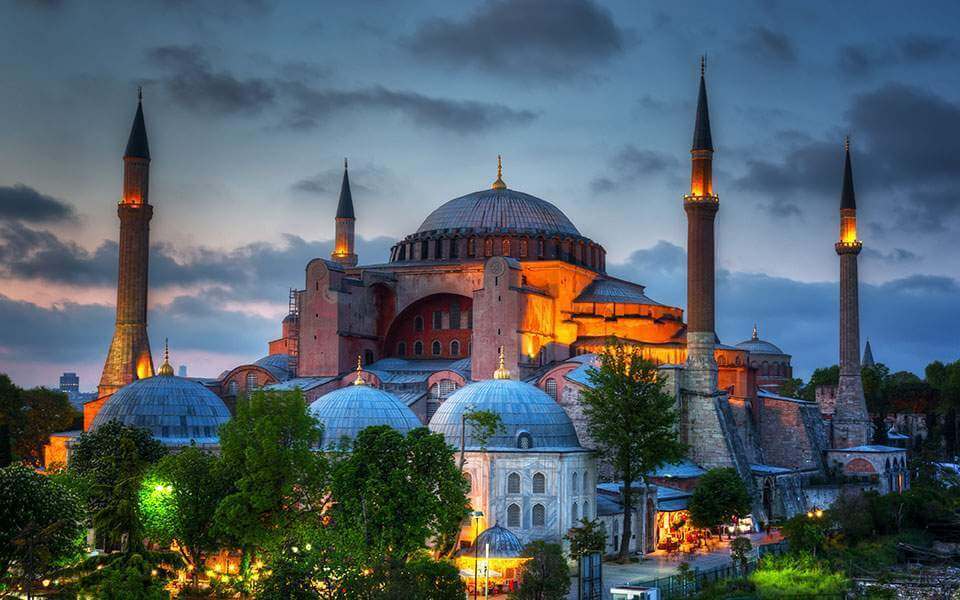The world-famous Hagia Sophia museum in Istanbul, originally founded as a cathedral, has been turned back into a mosque. Turkey’s President Recep Tayyip Erdogan announced the decision after a court annulled the site’s museum status. An in-depth report by Tabassum, exclusively for Different Truths.
 “Not Christian or Jew or Muslim, not Hindu, Buddhist, Sufi, or Zen. Not any religion or cultural system. I am not from the East or the West, not out of the ocean or up from the ground, not natural or ethereal, not composed of elements at all. I do not exist, am not an entity in this world or the next, did not descend from Adam or Eve or any origin story. My place is placeless, a trace of the traceless. Neither body nor soul. I belong to the beloved, have seen the two worlds as one and that one call to and know, first, last, outer, inner, only that breath breathing human being.” ~ Melvana Jamaluddin Rumi
“Not Christian or Jew or Muslim, not Hindu, Buddhist, Sufi, or Zen. Not any religion or cultural system. I am not from the East or the West, not out of the ocean or up from the ground, not natural or ethereal, not composed of elements at all. I do not exist, am not an entity in this world or the next, did not descend from Adam or Eve or any origin story. My place is placeless, a trace of the traceless. Neither body nor soul. I belong to the beloved, have seen the two worlds as one and that one call to and know, first, last, outer, inner, only that breath breathing human being.” ~ Melvana Jamaluddin Rumi
The world-famous Hagia Sophia museum in Istanbul, originally founded as a cathedral, has been turned back into a mosque. Turkey’s President Recep Tayyip Erdogan announced the decision after a court annulled the site’s museum status.
Built 1,500 years ago as an Orthodox Christian cathedral, Hagia Sophia was converted into a mosque after the Ottoman conquest, in 1453. In 1934, it became a museum and is now a UNESCO World Heritage site.
Making changes at Hagia Sophia is profoundly symbolic. It was Kemal Ataturk, the founder of modern Turkey, who decreed that it should be a museum. The decision is one more step to dismantle Ataturk’s secular legacy. Certainly, politics is at play in turning the museum into the mosque.
Making changes at Hagia Sophia is profoundly symbolic. It was Kemal Ataturk, the founder of modern Turkey, who decreed that it should be a museum. The decision is one more step to dismantle Ataturk’s secular legacy. Certainly, politics is at play in turning the museum into the mosque. The concerning fact is Hagia Sophia was an outstanding beacon of religious harmony and secularism. And now, the example is gone. The Babri Mosque verdict in India may inspire others to claim the disputed Gyanvapi mosque, Varanasi, Uttar Pradesh, Shahi Idgah mosque, Mathura, Uttar Pradesh, Kamal Mawla Mosque Madhya Pradesh, Quwwat ul-Islam mosque Qutub Minar compound Delhi. Similarly, this ruling by the Turkish court might encourage fundamentalists to claim the conversion of worship places.
The never-ending conflict is going on regarding the custodianship of Masjid-ul-Aksa between Palestine and Israel.
The mosque of Job in Al-Shaykh Saad, Syria was previously a church of Job. The  Herodian shrine of the Cave of the Patriarchs in Hebron, the second most holy site in Judaism, was converted into a church during the Crusades before being turned into a mosque, in 1266, and henceforth banned to Jews and Christians. Part of it was restored as a synagogue, by Israel, after 1967. After the Islamic conquest of Persia, Zoroastrian fire temples, with their four axial arch openings, were usually turned into mosques.
Herodian shrine of the Cave of the Patriarchs in Hebron, the second most holy site in Judaism, was converted into a church during the Crusades before being turned into a mosque, in 1266, and henceforth banned to Jews and Christians. Part of it was restored as a synagogue, by Israel, after 1967. After the Islamic conquest of Persia, Zoroastrian fire temples, with their four axial arch openings, were usually turned into mosques.
Following the Ottoman conquest, many churches were turned into mosques in Turkey, Cyprus, France, Greece, Hungary, Lebanon, Morocco, Spain, and in Syria. Among these churches, some were later re-converted into churches.
Following the Ottoman conquest, many churches were turned into mosques in Turkey, Cyprus, France, Greece, Hungary, Lebanon, Morocco, Spain, and in Syria. Among these churches, some were later reconverted into churches.
The Islamic State of Iraq and Syria converted a number of Christian churches into mosques after they occupied in Mosul, in 2014.
There are histories of Mosques turned into Churches as well. Most notably, Mosque-Cathedral of Córdoba, Mosque of Cristo de la Luz, including 16 mosques were turned into churches in Spain.
In India, Jama Masjid of Sonipat was turned into Durga Mandir, Jama Masjid of Farrukhnagar was turned into Ram Leela Mandir.
Hagia Sophia was one of the finest examples of religious co-existence and secularism and humanity. It is indeed a matter of sorrow to see Turkey setting up such a precedent when Turkey is the country of one of the great mystic Mevlana Jamaluddin Rumi (K.S), who dedicated his life for peace, coexistence, harmony, humanity and secularism.
We could easily include many names in the list from history. But what’s in it? Hagia Sophia was one of the finest examples of religious co-existence and secularism and humanity. It is indeed a matter of sorrow to see Turkey setting up such a precedent when Turkey is the country of one of the great mystic Mevlana Jamaluddin Rumi (K.S), who dedicated his life for peace, coexistence, harmony, humanity and secularism. The extract from his poem, at the beginning of this article, is an example of beauty in humanity.
The only piece of good news is Turkish officials say Christian emblems, including mosaics of the Virgin Mary, which adorn its soaring golden dome, will not be removed.
In 1453, Sultan Mehmed II invaded Istanbul. Hagia Sophia was not exempted from the pillage and looting. But instead of completely destroying it, he ordered, Hagia Sophia, to be transformed into a mosque. Islam does not allow the destruction of places of worship, but rather it guarantees the protection of churches, temples and other houses of worship belonging to non-Muslims both within and outside Islamic lands. The Prophet (PBUH) granted a constitutional status this protection through his commands, contracts, agreements and accords.
Islam does not allow the destruction of places of worship, but rather it guarantees the protection of churches, temples and other houses of worship belonging to non-Muslims both within and outside Islamic lands. The Prophet (PBUH) granted a constitutional status this protection through his commands, contracts, agreements and accords.
The Constitution of Medina, a formal agreement between the Prophet (PBUH) and all the significant tribes and families of Medina (including Muslims, Jews and  pagans), declared that non-Muslims in the Ummah had the following two important rights:
pagans), declared that non-Muslims in the Ummah had the following two important rights:
- The security of God is equal for all groups,
- Non-Muslim members have equal political and cultural rights as Muslims. They will have autonomy and freedom of religion.
Unfortunately, some part of the Muslim community is celebrating the new status of Hagia Sophia. On the other side, there are concerns from His Holiness Pope Francis, UNESCO, Greek Orthodox Church and secular minds.
Sultan Mehmet II and his successors ordered under Islamic law, the figural mosaics either, to removed or plastered over, a huge loss and a warning of what might happen again. Though Turkish officials announced that they will be covered by curtains or lasers during Muslim prayers.
To turn the unparalleled building back into a place of worship threatens open access to a magnificent structure and the building’s priceless mosaic decorations. By restricting access to Istanbul’s greatest historical legacy, the new decision attacks the diverse traditions that make Turkey itself a junction for the world.
Noble Laureate Orhan Pamuk said the decision would take away the ‘pride’ some Turks had in being a secular Muslim nation. “There are millions of secular Turks like me, who are crying against this but their voices are not heard,” he told the BBC
Noble Laureate Orhan Pamuk said the decision would take away the ‘pride’ some Turks had in being a secular Muslim nation. “There are millions of secular Turks like me, who are crying against this but their voices are not heard,” he told the BBC
It is the cry of not only the Turks but also those who believe profoundly in secularism, humanity and aestheticism. The secular community feels that the monument belongs to humanity – not to Turkey – and should have remained unchanged. Because it was a bridge between two faiths and a symbol of co-existence. This decision threatens the country’s secular character and Istanbul’s historic role as a tolerant metropolis where Muslim, Christian and Jewish faiths coexisted for centuries.
Hagia Sophia belongs to the world. Its fate is not just a matter to be decided by the court order. Because Hagia Sophia is a universal symbol of humanity, secularism and aesthetic beauty of architecture.
Photos sourced by the author





 By
By
 By
By
